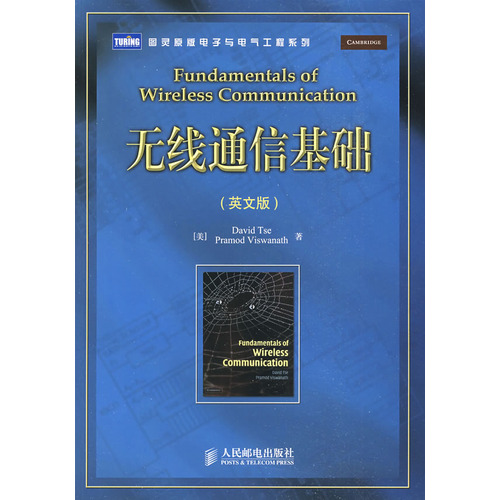书籍介绍
 |
无线通信基础 |
|
| 作 者: 谢(Tse,D) 维斯瓦纳斯 | ||
| 出 版 社: 人民邮电出版社 | ||
| 书 号: 9787115200709 | ||
| 页 数: 564 页 | ||
| 出版日期: 2009-8-11 | ||
| 定 价: ¥0 元 | ||
|
无线通信基础简介
作者简介
David Tse博士,是无线通信领域新一代权威,现任加州大学伯克利分校电气工程与计算机科学系教授,毕业于麻省理工学院。 目录 1 Introduction 1.1 Book objective 1.2 Wireless systems 1.3 Book outline 2 The wireless channel 2.1 Physical modeling for wireless channels 2.1.1 Free space, fixed transmit and receive antennas 2.1.2 Free space, moving antenna 2.1.3 Reflecting wall, fixed antenna 2.1.4 Reflecting wall, moving antenna 2.1.5 Reflection from a ground plane 2.1.6 Power decay with distance and shadowing 2.1.7 Moving antenna, multiple reflectors 2.2 Input/output model of the wireless channel 2.2.1 The wireless channel as a linear time-varying system 2.2.2 Baseband equivalent model 2.2.3 A discrete-time baseband model Discussion 2.1 Degrees of freedom 2.2.4 Additive white noise 2.3 Time and frequency coherence 2.3.1 Doppler spread and coherence time 2.3.2 Delay spread and coherence bandwidth 2.4 Statistical channel models 2.4.1 Modeling philosophy 2.4.2 Rayleigh and Rician fading 2.4.3 Tap gain auto-correlation function Example 2.1 Clarke’s model Chapter 2 The main plot 2.5 Bibliographical notes 2.6 Exercises 3 Point-to-point communication: detection, diversity, and channel ncertainty 3.1 Detection in a Rayleigh fading channel 3.1.1 Non-coherent detection 3.1.2 Coherent detection 3.1.3 From BPSK to QPSK: exploiting the degrees of freedom 3.1.4 Diversity 3.2 Time diversity 3.2.1 Repetition coding 3.2.2 Beyond repetition coding Summary 3.1 Time diversity code design criterion Example 3.1 Time diversity in GSM 3.3 Antenna diversity 3.3.1 Receive diversity 3.3.2 Transmit diversity: space-time codes 3.3.3 MIMO: a 2×2 example Summary 3.2 2×2 MIMO schemes 3.4 Frequency diversity 3.4.1 Basic concept 3.4.2 Single-carrier with ISI equalization 3.4.3 Direct-sequence spread-spectrum 3.4.4 Orthogonal frequency division multiplexing Summary 3.3 Communication over frequency-selective channels 3.5 Impact of channel uncertainty 3.5.1 Non-coherent detection for DS spread-spectrum 3.5.2 Channel estimation 3.5.3 Other diversity scenarios Chapter 3 The main plot 3.6 Bibliographical notes 4 Cellular systems: multiple access and interference management 4.1 Introduction 4.2 Narrowband cellular systems 4.2.1 Narrowband allocations: GSM system 4.2.2 Impact on network and system design 4.2.3 Impact on frequency reuse Summary 4.1 Narrowband systems 4.3 Wideband systems: CDMA 4.3.1 CDMA uplink 4.3.2 CDMA downlink 4.3.3 System issues Summary 4.2 CDMA 4.4 Wideband systems: OFDM 4.4.1 Allocation design principles 4.4.2 Hopping pattern 4.4.3 Signal characteristics and receiver design 4.4.4 Sectorization Example 4.1 Flash-OFDM Chapter 4 The main plot 4.5 Bibliographical notes 4.6 Exercises 5 Capacity of wireless channels 5.1 AWGN channel capacity 5.1.1 Repetition coding 5.1.2 Packing spheres Discussion 5.1 Capacity-achieving AWGN channel codes Summary 5.1 Reliable rate of communication and capacity 5.2 Resources of the AWGN channel 5.2.1 Continuous-time AWGN channel 5.2.2 Power and bandwidth Example 5.2 Bandwidth reuse in cellular systems 5.3 Linear time-invariant Gaussian channels 5.3.1 Single input multiple output (SIMO) channel 5.3.2 Multiple input single output (MISO) channel 5.3.3 Frequency-selective channel 5.4 Capacity of fading channels 5.4.1 Slow fading channel 5.4.2 Receive diversity 5.4.3 Transmit diversity Summary 5.2 Transmit and receive diversity 5.4.4 Time and frequency diversity Summary 5.3 Outage for parallel channels 5.4.5 Fast fading channel 5.4.6 Transmitter side information Example 5.3 Rate adaptation in IS-856 5.4.7 Frequency-selective fading channels 5.4.8 Summary: a shift in point of view Chapter 5 The main plot 5.5 Bibliographical notes 5.6 Exercises 6 Multiuser capacity and opportunistic communication 6.1 Uplink AWGN channel 6.1.1 Capacity via successive interference cancellation 6.1.2 Comparison with conventional CDMA 6.1.3 Comparison with orthogonal multiple access 6.1.4 General K -user uplink capacity 6.2 Downlink AWGN channel 6.2.1 Symmetric case: two capacity-achieving schemes 6.2.2 General case: superposition coding achieves capacity Summary 6.1 Uplink and downlink AWGN capacity Discussion 6.1 SIC: implementation issues 6.3 Uplink fading channel 6.3.1 Slow fading channel …… 7 MIMO I: spatial multiplexing and channel modeling 8 MIMO II: capacity and multiplexing architectures 9 MIMO III: diversity–multiplexing tradeoff and universal space-time codes 10 MIMO IV: multiuser communication Appendix A Detection and estimation in additive Gaussian noise Appendix B Information theory from first principles References Index | ||



